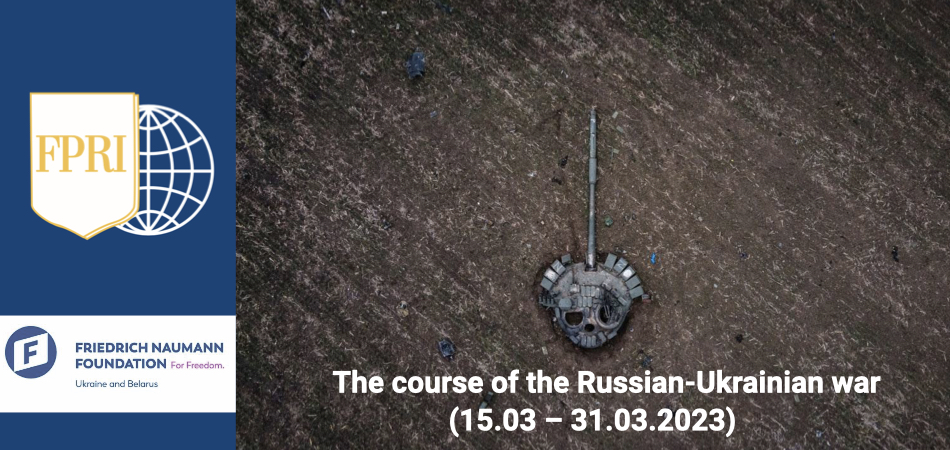
Source: Army FM
- Changes at the front
Ukraine and Russia have reached a tactical balance on the front. The question remains, who will have the strategic advantage?
Russian troops conducted limited ground attacks on the Svatove-Kreminna line, near settlement Dibrova, Hryhorivka, Belogorivka, Verkhnokamianske, Spirne and Makiivka. There were no significant changes in the front line in this direction, the Russian troops did not manage to achieve a significant advance.
In the Bakhmut direction, the Russian Federation is trying to take full control of the city of Bakhmut. Fighting continues in the city center. According to the Supreme Commander-in-Chief of Ukraine, if Ukrainian troops in Bakhmut are threatened by the encirclement, a decision will be made to withdraw units from the city. Also, Russia is conducting offensive actions in the area of Bohdanivka and Ivanivske.
On the Avdiyivka and Mariinka directions, the enemy carried out offensive actions in the Novokalynove, Severne, Pervomaiske and Mariinka districts of the Donetsk region, without success. At the same time, the enemy shelled the settlements of Novobakhmutivka, Novokalynove, Avdiivka, Vodyane, Pervomaiske, Krasnohorivka, Georgiivka, and Maryinka.
Shelling of Ukrainian positions continues in the Vuhledar direction. At the moment, the Russian Federation is not trying to advance towards Vuhledar.
In the southern direction, the occupying forces continue to strengthen their defensive positions.
- Military assistance
In the second half of March, it became known about the transfer of the following weapons to Ukraine:
Poland:
- MiG 29 (4 units)
- Self-propelled anti-aircraft gun -23-4 "Shilka"
France:
- AMX-10RC
Canada:
- BREM Bergepanzer 3
USA:
- Avenger air defense system
- Oshkosh M-ATV
- patrol boats "40 Defiant"
- Cougar armored vehicles
- Stryker armored personnel carrier
Slovakia:
- SAM "Kub"
- MiG 29 (4 units)
Belgium:
- 240 Volvo military trucks
FRG:
- missiles for MARS II anti-aircraft missiles
- 5 thousand 155 mm caliber artillery shells
- 500 SFP9 pistols
- two forklifts
- four mobile antenna-mast systems
- two hangar awnings
- 25 generators
- BMP Marder
- Pionierpanzer Dachs engineering vehicles (3 units)
- 70 MG3 machine guns for Leopard 2 tanks
Lithuania:
- 155 mm caliber ammunition
Portugal:
- Leopard 2A6 tanks (3 units)
Norway:
- Leopard 2A4NO tanks (8 units)
- Bergepanzer 2 armored repair and evacuation vehicles (2 units)
- Engineering vehicles NM189 Ingeniorpanservogn (2 units)
Finland:
- Leopard 2R armored demining vehicles (6 units)
United Kingdom:
- Challenger 2 tanks
The US approved a new aid package, which included: ammunition for the HIMARS multiple-launch rocket systems; 155 mm caliber artillery shells; 25 mm caliber ammunition; high-speed anti-radar missiles (HARM); 81-mm and 60-mm mortars and ammunition for them; AT-4 anti-tank grenade launchers; grenade launchers, small arms and ammunition for them; explosive charges and equipment for clearing obstacles; demining equipment; refueling stations; thermal imaging systems, optical devices and laser rangefinders; river patrol boats; test and diagnostic equipment for maintenance and repair of vehicles; spare parts and other field equipment.
Source: Mil.ua
- Russia: internal and external challenges
Currently, the strategic initiative remains with the Russian Federation, however, the Russians do not have a strategic advantage. The further course of the Russian-Ukrainian war will depend on which of the parties will be able to concentrate more forces and resources. Ukraine has no aviation and long-range missiles, which postpones a counteroffensive due to a lack of means to conduct an offensive operation. Ukraine depends on the help of partners, but until now this help has not been enough. At the same time, the Russian Federation is trying to restore forces by mobilizing an additional 400,000 people. Therefore, in conditions of equilibrium, both sides try to tilt the scales in their favor, to ensure the strengthening of their own capabilities, or to divert the strengthening of the opponent. The Russian Federation is resorting to blackmailing Ukraine's partners, as in the case of British shells made of depleted uranium. These projectiles have nothing to do with nuclear weapons, however, Russian nuclear rhetoric intensified after the announcement of Great Britain's intentions to transfer these projectiles to the Armed Forces. In this way, Russia is trying to divert the strengthening of the Ukrainian army due to more effective weapons.
Ukraine has not yet received enough weapons for an effective counter-offensive in several directions. In addition to the reluctance to transfer more modern aircraft and longer-range missiles, military assistance is limited by the capabilities of NATO member states. The stocks of the countries of the North Atlantic Alliance are running out, and replacement with more modern equipment takes time. As NATO countries order new ones to replace older models, their complete rearmament is a matter of time. The war in Ukraine, however, is in full swing and Ukraine needs weapons here and now. Therefore, in order to defeat Russia, the United States and the Allies must launch their military-industrial complex at a greater power. An increase in the resources received by the Defense Forces of Ukraine can tip the balance in the struggle for strategic advantage in favor of Ukraine.
